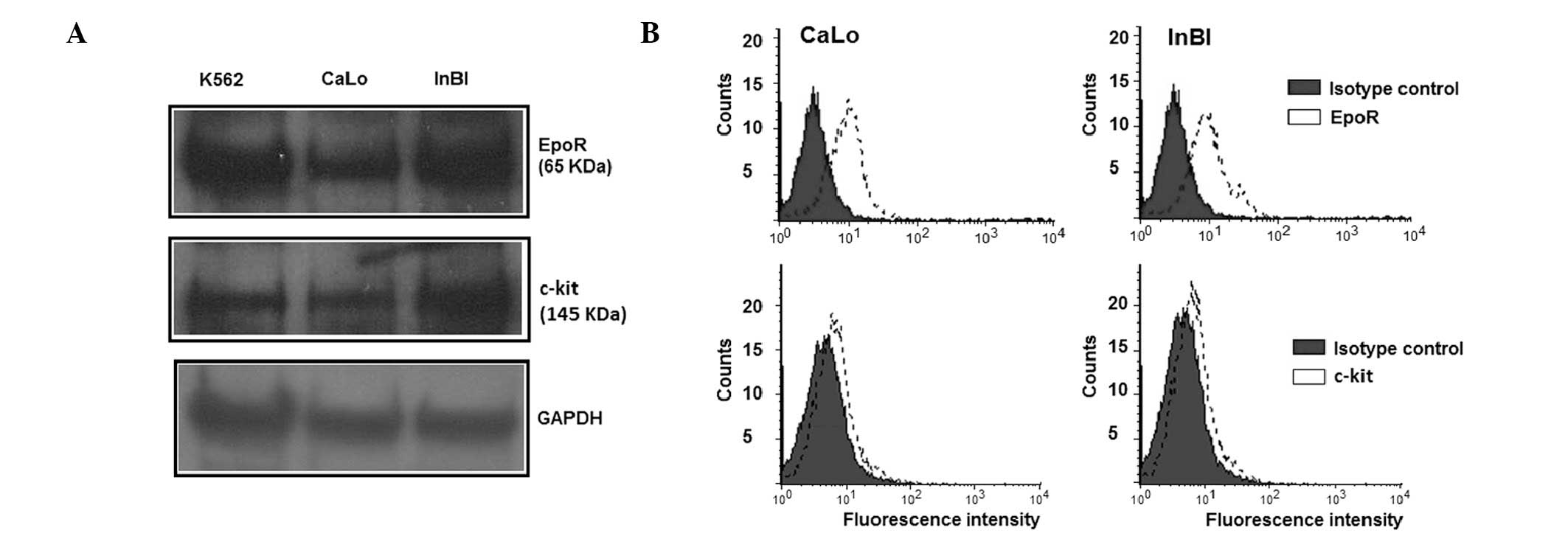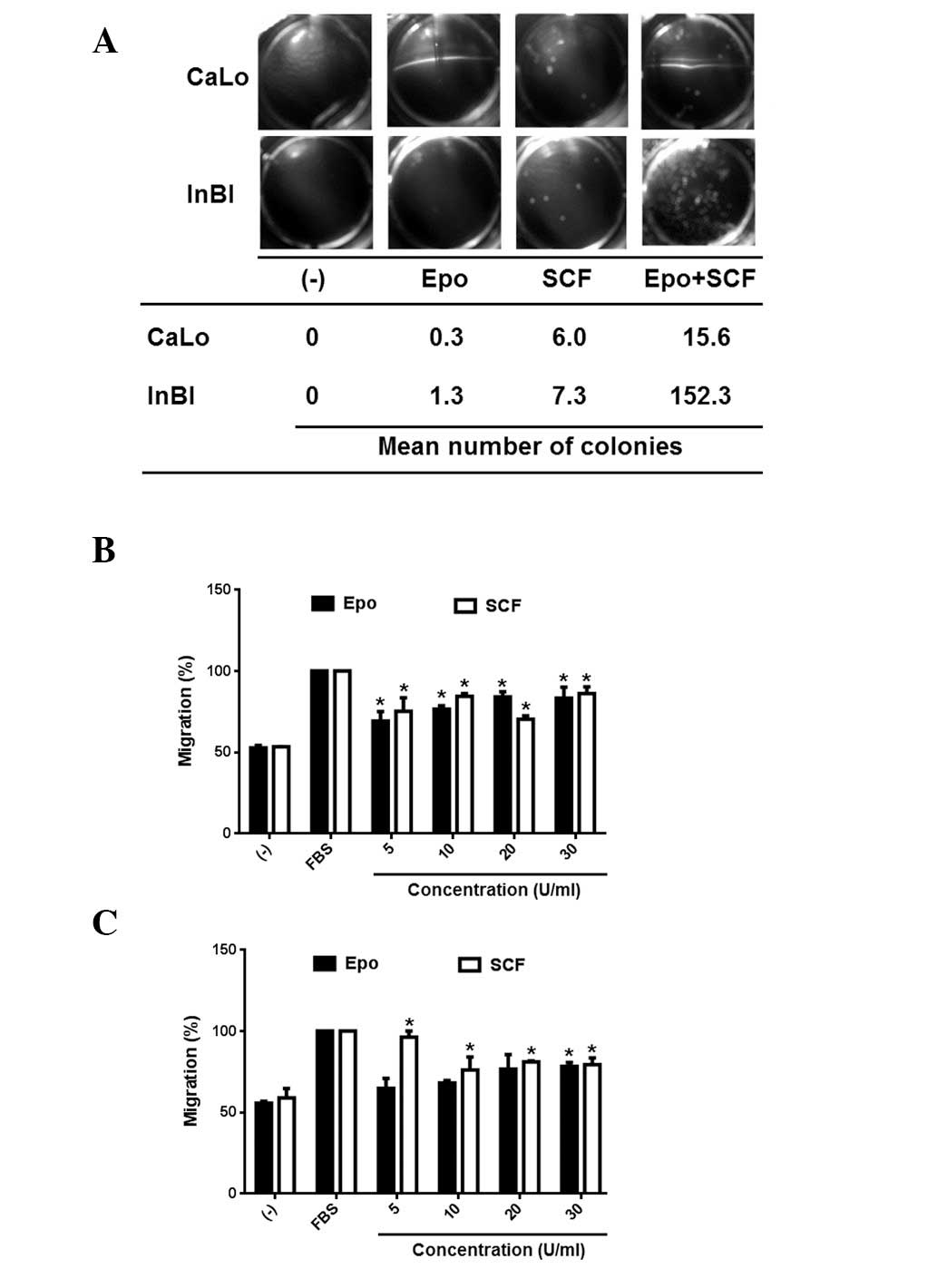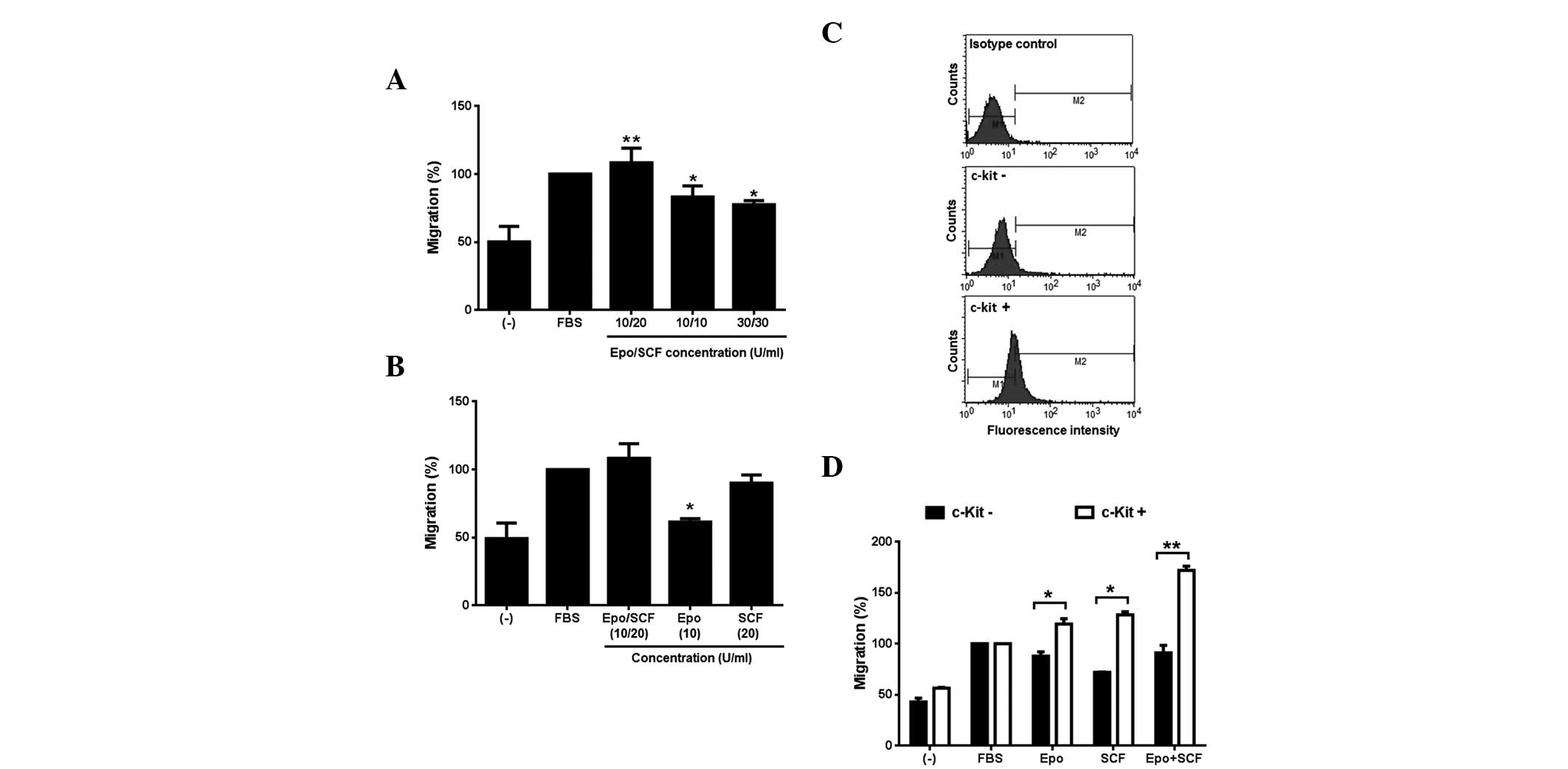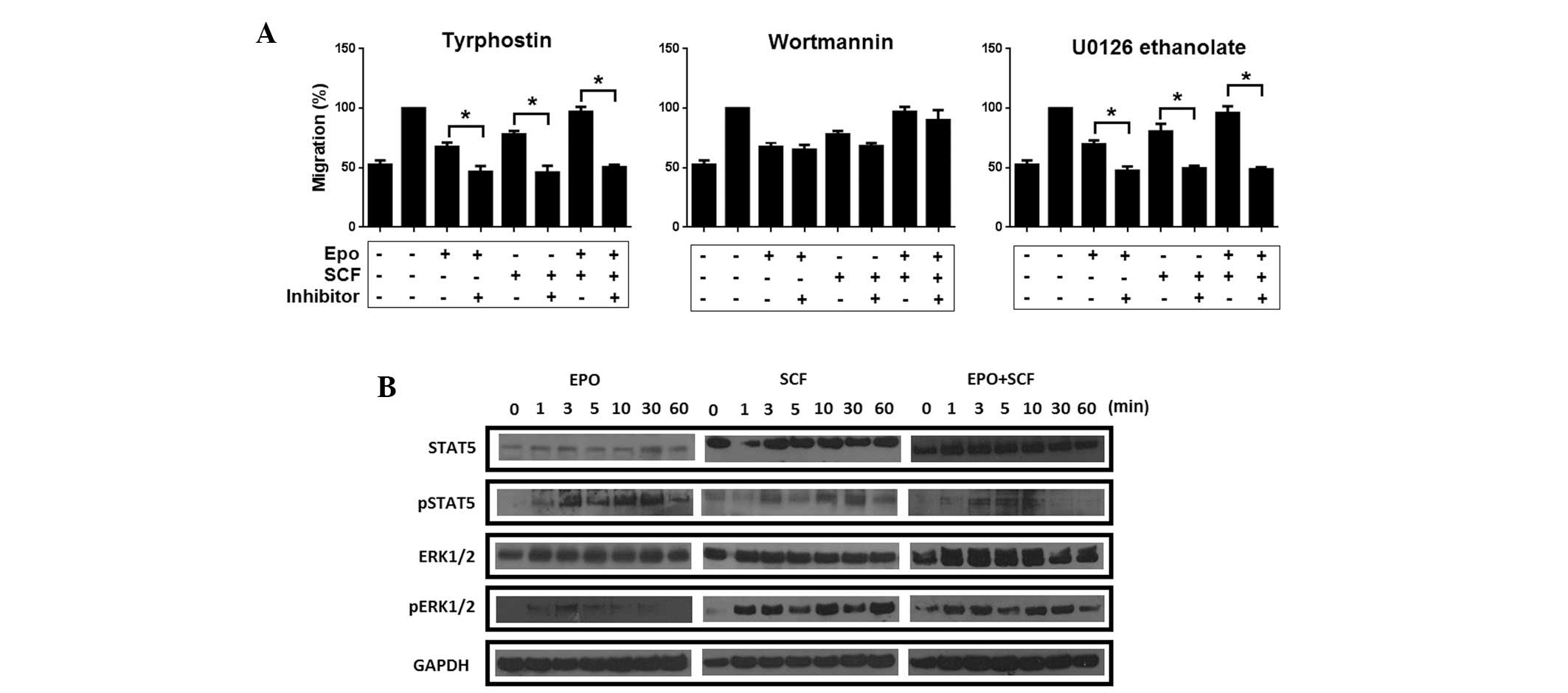|
1
|
Witthuhn BA, Quelle FW, Silvennoinen O, Yi
T, Tang B, Miura O and Ihle JN: JAK2 associates with the
erythropoietin receptor and is tyrosine phosphorylated and
activated following stimulation with erythropoietin. Cell.
74:227–236. 1993. View Article : Google Scholar : PubMed/NCBI
|
|
2
|
Bao H, Jacobs-Helber SM, Lawson AE, Penta
K, Wickrema A and Sawyer ST: Protein kinase B (c-Akt),
phosphatidylinositol 3-kinase, and STAT5 are activated by
erythropoietin (EPO) in HCD57 erythroid cells but are
constitutively active in an EPO-independent, apoptosis-resistant
subclone (HCD57-SREI cells). Blood. 93:3757–3773. 1999.PubMed/NCBI
|
|
3
|
Sokolovsky M, Nam H, Fleming MD, Haase VH,
Brugnara C and Lodish HF: Ineffective erythropoiesis in
Stat5a(−/−)5b(−/−) mice due to decreased survival of early
erythroblasts. Blood. 98:3261–3273. 2001.PubMed/NCBI
|
|
4
|
Damen JE, Wakao H, Miyajima A, Krosl J,
Humphries RK, Cutler RL and Krystal G: Tyrosine 343 in the
erythropoietin receptor positively regulates erythropoietin-induced
cell proliferation and Stat5 activation. EMBO J. 14:5557–5568.
1995.PubMed/NCBI
|
|
5
|
Blume-Jensen P, Janknecht R and Hunter T:
The kit receptor promotes cell survival via activation of PI
3-kinase and subsequent Akt-mediated phosphorylation of Bad on
Ser136. Curr Biol. 8:779–782. 1998. View Article : Google Scholar : PubMed/NCBI
|
|
6
|
Krystal GW, DeBerry CS, Linnekin D and
Litz J: Lck associates with and is activated by Kit in a small cell
lung cancer cell line: inhibition of SCF-mediated growth by the Src
family inhibitor PP1. Cancer Res. 58:4660–4666. 1998.PubMed/NCBI
|
|
7
|
Sundström M, Alfredsson J, Olsson N and
Nilsson G: Stem cell factor-induced migration of mast cells
requires p38 mitogen-activated protein kinase activity. Exp Cell
Res. 267:144–151. 2001.PubMed/NCBI
|
|
8
|
Maddens S, Charruyer A, Plo I, Dubreuil P,
Berger S, Salles B, Laurent G and Jaffrézou JP: Kit signalling
inhibits the sphingomyelin-ceramide pathway through PLC gamma 1:
implication in stem cell factor radioprotective effect. Blood.
100:1294–1301. 2002.PubMed/NCBI
|
|
9
|
Trieselmann NZ, Soboloff J and Berger SA:
Mast cells stimulated by membrane-bound, but not soluble, steel
factor are dependent on phospholipase C activation. Cell Mol Life
Sci. 60:759–766. 2003. View Article : Google Scholar : PubMed/NCBI
|
|
10
|
Wu H, Klingmüller U, Besmer P and Lodish
HF: Interaction of the erythropoietin and stem-cell-factor
receptors. Nature. 377:242–246. 1995. View
Article : Google Scholar : PubMed/NCBI
|
|
11
|
Wu H, Klingmüller U, Acurio A, Hsiao JG
and Lodish HF: Functional interaction of erythropoietin and stem
cell factor receptors is essential for erythroid colony formation.
Proc Natl Acad Sci USA. 94:1806–1810. 1997. View Article : Google Scholar : PubMed/NCBI
|
|
12
|
Hong L, Ramdas B, Chen J, Harris C,
Wojchowski DM and Kapur R: KIT associated intracellular tyrosines
play an essential role in EpoR co-signalling. Cell Signal.
20:1513–1520. 2008. View Article : Google Scholar : PubMed/NCBI
|
|
13
|
Farrell F and Lee A: The erythropoietin
receptor and its expression in tumor cells and other tissues.
Oncologist. 9(Suppl 5): 18–30. 2004. View Article : Google Scholar : PubMed/NCBI
|
|
14
|
Horie K, Fujita J, Takakura K, Kanzaki H,
Suginami H, Iwai M, Nakayama H and Mori T: The expression of c-kit
protein in human adult and fetal tissues. Hum Reprod. 8:1955–1962.
1993.PubMed/NCBI
|
|
15
|
Shenouda G, Mehio A, Souhami L, Duclos M,
Portelance L, Belenkov A and Chow T: Erythropoietin receptor
expression in biopsy specimens from patients with uterine cervix
squamous cell carcinoma. Int J Gynecol Cancer. 16:752–756. 2006.
View Article : Google Scholar : PubMed/NCBI
|
|
16
|
Caceres-Cortes JR, Alvarado-Moreno JA,
Waga K, Rangel-Corona R, Monroy-Garcia A, Rocha-Zavaleta L,
Urdiales-Ramos J, Weiss-Steider B, Haman A, Hugo P, et al:
Implication of tyrosine kinase receptor and steel factor in cell
density-dependent growth in cervical cancers and leukemias. Cancer
Res. 61:6281–6289. 2001.PubMed/NCBI
|
|
17
|
Lopez TV, Lappin TR, Maxwell P, Shi Z,
Lopez-Marure R, Aguilar C and Rocha-Zavaleta L: Autocrine/paracrine
erythropoietin signalling promotes JAK/STAT-dependent proliferation
of human cervical cancer cells. Int J Cancer. 129:2566–2576. 2011.
View Article : Google Scholar
|
|
18
|
Mohyeldin A, Lu H, Dalgard C, Lai SY,
Cohen N, Acs G and Verma A: Erythropoietin signaling promotes
invasiveness of human head and neck squamous cell carcinoma.
Neoplasia. 7:537–543. 2005. View Article : Google Scholar : PubMed/NCBI
|
|
19
|
Lester RD, Jo M, Campana WM and Gonias SL:
Erythropoietin promotes MCF-7 breast cancer cell migration by an
ERK/mitogen-activated protein kinase-dependent pathway and is
primarily responsible for the increase in migration observed in
hypoxia. J Biol Chem. 280:39273–39277. 2005. View Article : Google Scholar
|
|
20
|
Hamadmad SN and Hohl RJ: Erythropoietin
stimulates cancer cell migration and activates RhoA protein through
a mitogen-activated protein kinase/extracellular signal-regulated
kinase-dependent mechanism. J Pharmacol Exp Ther. 324:1227–1233.
2008. View Article : Google Scholar
|
|
21
|
Fraser JK, Lin FK and Berridge MV:
Expression and modulation of specific, high affinity binding sites
for erythropoietin on the human erythroleukemic cell line K562.
Blood. 71:104–109. 1988.PubMed/NCBI
|
|
22
|
Fujisue Y, Nakagawa T, Takahara K, Inamoto
T, Kiyama S, Azuma H and Asahi M: Induction of erythropoietin
increases the cell proliferation rate in a hypoxia-inducible
factor-1-dependent and -independent manner in renal cell carcinoma
cell lines. Oncol Lett. 5:1765–1770. 2013.PubMed/NCBI
|
|
23
|
Kumar SM, Zhang G, Bastian BC, Arcasoy MO,
Karande P, Pushparajan A, Acs G and Xu X: Erythropoietin receptor
contributes to melanoma cell survival in vivo. Oncogene.
31:1649–1660. 2012. View Article : Google Scholar : PubMed/NCBI
|
|
24
|
Steinmann K, Richter AM and Dammann RH:
Epigenetic silencing of erythropoietin in human cancers. Genes
Cancer. 2:65–73. 2011. View Article : Google Scholar : PubMed/NCBI
|
|
25
|
Jeong JY, Hoxhaj G, Socha AL, Sytkowski AJ
and Feldman L: An erythropoietin autocrine/paracrine axis modulates
the growth and survival of human prostate cancer cells. Mol Cancer
Res. 7:1150–1157. 2009. View Article : Google Scholar : PubMed/NCBI
|
|
26
|
Inoue M, Kyo S, Fujita M, Enomoto T and
Kondoh G: Coexpression of the c-kit receptor and the stem cell
factor in gynecological tumors. Cancer Res. 54:3049–3053.
1994.PubMed/NCBI
|
|
27
|
Kapur R, Cooper R, Zhang L and Williams
DA: Cross-talk between alpha(4)beta(1)/alpha(5)beta(1) and c-Kit
results in opposing effect on growth and survival of hematopoietic
cells via the activation of focal adhesion kinase,
mitogen-activated protein kinase, and Akt signalling pathways.
Blood. 97:1975–1981. 2001. View Article : Google Scholar
|
|
28
|
Yang FC, Kapur R, King AJ, Tao W, Kim C,
Borneo J, Breese R, Marshall M, Dinauer MC and Williams DA: Rac2
stimulates Akt activation affecting BAD/Bcl-XL expression while
mediating survival and actin function in primary mast cells.
Immunity. 12:557–568. 2000. View Article : Google Scholar : PubMed/NCBI
|
|
29
|
Fraser L, Taylor AH and Forrester LM:
SCF/KIT inhibition has a cumulative but reversible effect on the
self-renewal of embryonic stem cells and on the survival of
differentiating cells. Cell Reprogram. 15:259–268. 2013.PubMed/NCBI
|
|
30
|
Liu L, Zhang X, Do C, Zhang X, Hou N, Zhao
D, Sun J, Li L, Wang X and Ma C: MEK1-independent activation of
MAPK and MEK1-dependent activation of p70 S6 kinase by stem cell
factor (SCF) in ovarian cancer cells. Biochem Biophys Res Commun.
382:385–389. 2009. View Article : Google Scholar : PubMed/NCBI
|
|
31
|
Bellone G, Carbone A, Sibona N, Bosco O,
Tibaudi D, Smirne C, Martone T, Gramigni C, Camandona M, Emanuelli
G and Rodeck U: Aberrant activation of c-kit protects colon
carcinoma cells against apoptosis and enhances their invasive
potential. Cancer Res. 61:2200–2206. 2001.PubMed/NCBI
|
|
32
|
Shi Z, Hodges VM, Dunlop EA, Percy MJ,
Maxwell AP, El-Tanani M and Lappin TR: Erythropoietin-induced
activation of the JAK2/STAT5, PI3K/Akt, and Ras/ERK pathways
promotes malignant cell behavior in a modified breast cancer cell
line. Mol Cancer Res. 8:615–626. 2010. View Article : Google Scholar : PubMed/NCBI
|
|
33
|
Wu H, Klingmüller U, Bersmer P and Lodish
HF: Interaction of the erythropoietin and stem-cell-factor
receptors. Nature. 377:242–246. 1995. View
Article : Google Scholar : PubMed/NCBI
|
|
34
|
Grebier F, Kerenyi MA, Kovacic B, Kolbe T,
Becker V, Dolznig H, Pfeffer K, Klingmüller U, Müller M, Beug H, et
al: Stat5 activation enables erythropoiesis in the absence of EpoR
and Jak2. Blood. 111:4511–4522. 2008. View Article : Google Scholar : PubMed/NCBI
|
|
35
|
Sui X, Krantz SB, You M and Zhao Z:
Synergistic activation of MAP kinase (ERK1/2) by erythropoietin and
stem cell factor is essential for expanded erythropoiesis. Blood.
92:1142–1149. 1998.PubMed/NCBI
|














